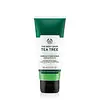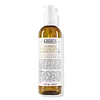What's inside
What's inside
 Key Ingredients
Key Ingredients

No key ingredients
 Benefits
Benefits

 Concerns
Concerns

 Ingredients Side-by-side
Ingredients Side-by-side

Water
Skin ConditioningSodium Laureth Sulfate
CleansingGlycerin
HumectantLauryl Betaine
CleansingAcrylates Copolymer
PEG-40 Hydrogenated Castor Oil
EmulsifyingPropanediol
SolventPerlite
AbsorbentPhenoxyethanol
PreservativeMelaleuca Alternifolia Leaf Oil
AntioxidantMannitol
HumectantSodium Chloride
MaskingP-Anisic Acid
MaskingSodium Hydroxide
BufferingCellulose
AbsorbentPEG-120 Methyl Glucose Dioleate
EmulsifyingAcacia Concinna Fruit Extract
Skin ConditioningBalanites Aegyptiaca Fruit Extract
Menthol
MaskingDisodium EDTA
Gypsophila Paniculata Root Extract
Skin ConditioningCalophyllum Inophyllum Seed Oil
AntimicrobialLimonene
PerfumingCitral
PerfumingTocopheryl Acetate
AntioxidantPotassium Sorbate
PreservativeSodium Benzoate
MaskingCitronellol
PerfumingLinalool
PerfumingSorbic Acid
PreservativeHydroxypropyl Methylcellulose
Emulsion StabilisingLeptospermum Petersonii Oil
MaskingCitric Acid
BufferingTocopherol
AntioxidantCI 19140
Cosmetic ColorantCI 42090
Cosmetic ColorantWater, Sodium Laureth Sulfate, Glycerin, Lauryl Betaine, Acrylates Copolymer, PEG-40 Hydrogenated Castor Oil, Propanediol, Perlite, Phenoxyethanol, Melaleuca Alternifolia Leaf Oil, Mannitol, Sodium Chloride, P-Anisic Acid, Sodium Hydroxide, Cellulose, PEG-120 Methyl Glucose Dioleate, Acacia Concinna Fruit Extract, Balanites Aegyptiaca Fruit Extract, Menthol, Disodium EDTA, Gypsophila Paniculata Root Extract, Calophyllum Inophyllum Seed Oil, Limonene, Citral, Tocopheryl Acetate, Potassium Sorbate, Sodium Benzoate, Citronellol, Linalool, Sorbic Acid, Hydroxypropyl Methylcellulose, Leptospermum Petersonii Oil, Citric Acid, Tocopherol, CI 19140, CI 42090
Water
Skin ConditioningSodium Cocoyl Glycinate
CleansingCoco-Betaine
CleansingGlycerin
HumectantAcrylates Copolymer
Sodium Chloride
MaskingPhenoxyethanol
PreservativeCitrus Limon Peel Oil
MaskingLimonene
PerfumingSodium Hydroxide
BufferingTetrasodium EDTA
Propylene Glycol
HumectantGeranium Maculatum Oil
MaskingCitral
PerfumingCalendula Officinalis Flower Extract
MaskingCymbopogon Schoenanthus Oil
MaskingArtemisia Absinthium Extract
Skin ConditioningCitric Acid
BufferingWater, Sodium Cocoyl Glycinate, Coco-Betaine, Glycerin, Acrylates Copolymer, Sodium Chloride, Phenoxyethanol, Citrus Limon Peel Oil, Limonene, Sodium Hydroxide, Tetrasodium EDTA, Propylene Glycol, Geranium Maculatum Oil, Citral, Calendula Officinalis Flower Extract, Cymbopogon Schoenanthus Oil, Artemisia Absinthium Extract, Citric Acid
 Reviews
Reviews

Ingredients Explained
These ingredients are found in both products.
Ingredients higher up in an ingredient list are typically present in a larger amount.
Acrylates Copolymer is used as a film-forming agent and texture enhancer.
After applied, Acrylates Copolymer forms a thin film cover that helps skin feel more soft. It can help sunscreens become more water-resistant.
It is also used to make a product more thick.
Learn more about Acrylates CopolymerCitral is a fragrance and used to add a lemon-like scent to products. It is both naturally found in plants and created synthetically. In plants, it is commonly occurring in lemon myrtle, lemongrass, lemon tea-tree, lemon verbena, and other citruses.
The EU mandates Citral be listed separately as a fragrance. It is a known allergen and may cause contact dermatitis. Citral can also used as a masking ingredient.
The term 'fragrance' is not regulated in many countries. In many cases, it is up to the brand to define this term. For instance, many brands choose to label themselves as "fragrance-free" because they are not using synthetic fragrances. However, their products may still contain ingredients such as essential oils that are considered a fragrance.
The term 'citral' is a collective term for two geometric isomers: geranial/Citral A and neral/Citral B.
Learn more about CitralCitric Acid is an alpha hydroxy acid (AHA) naturally found in citrus fruits like oranges, lemons, and limes.
Like other AHAs, citric acid can exfoliate skin by breaking down the bonds that hold dead skin cells together. This helps reveal smoother and brighter skin underneath.
However, this exfoliating effect only happens at high concentrations (20%) which can be hard to find in cosmetic products.
Due to this, citric acid is usually included in small amounts as a pH adjuster. This helps keep products slightly more acidic and compatible with skin's natural pH.
In skincare formulas, citric acid can:
While it can provide some skin benefits, research shows lactic acid and glycolic acid are generally more effective and less irritating exfoliants.
Most citric acid used in skincare today is made by fermenting sugars (usually from molasses). This synthetic version is identical to the natural citrus form but easier to stabilize and use in formulations.
Read more about some other popular AHA's here:
Learn more about Citric AcidGlycerin is already naturally found in your skin. It helps moisturize and protect your skin.
A study from 2016 found glycerin to be more effective as a humectant than AHAs and hyaluronic acid.
As a humectant, it helps the skin stay hydrated by pulling moisture to your skin. The low molecular weight of glycerin allows it to pull moisture into the deeper layers of your skin.
Hydrated skin improves your skin barrier; Your skin barrier helps protect against irritants and bacteria.
Glycerin has also been found to have antimicrobial and antiviral properties. Due to these properties, glycerin is often used in wound and burn treatments.
In cosmetics, glycerin is usually derived from plants such as soybean or palm. However, it can also be sourced from animals, such as tallow or animal fat.
This ingredient is organic, colorless, odorless, and non-toxic.
Glycerin is the name for this ingredient in American English. British English uses Glycerol/Glycerine.
Learn more about GlycerinLimonene is a fragrance that adds scent and taste to a formulation.
It's found in the peel oil of citrus fruits and other plants such as lavender and eucalyptus. The scent of limonene is generally described as "sweet citrus".
Limonene acts as an antioxidant, meaning it helps neutralize free radicals.
When exposed to air, oxidized limonene may sensitize the skin. Because of this, limonene is often avoided by people with sensitive skin.
The term 'fragrance' is not regulated in many countries. In many cases, it is up to the brand to define this term. For instance, many brands choose to label themselves as "fragrance-free" because they are not using synthetic fragrances. However, their products may still contain ingredients such as essential oils that are considered a fragrance.
Learn more about LimonenePhenoxyethanol is a preservative that has germicide, antimicrobial, and aromatic properties. Studies show that phenoxyethanol can prevent microbial growth. By itself, it has a scent that is similar to that of a rose.
It's often used in formulations along with Caprylyl Glycol to preserve the shelf life of products.
Chances are, you eat sodium chloride every day. Sodium Chloride is also known as table salt.
This ingredient has many purposes in skincare: thickener, emulsifier, and exfoliator.
You'll most likely find this ingredient in cleansers where it is used to create a gel-like texture. As an emulsifier, it also prevents ingredients from separating.
There is much debate on whether this ingredient is comedogenic. The short answer - comedogenic ratings don't tell the whole story. Learn more about comegodenic ratings here.
The concensus about this ingredient causing acne seems to be divided. Research is needed to understand if this ingredient does cause acne.
Scrubs may use salt as the primary exfoliating ingredient.
Learn more about Sodium ChlorideSodium Hydroxide is also known as lye or caustic soda. It is used to adjust the pH of products; many ingredients require a specific pH to be effective.
In small amounts, sodium hydroxide is considered safe to use. However, large amounts may cause chemical burns due to its high alkaline.
Your skin has a natural pH and acid mantle. This acid mantle helps prevent harmful bacteria from breaking through. The acid mantle also helps keep your skin hydrated.
"Alkaline" refers to a high pH level. A low pH level would be considered acidic.
Learn more about Sodium HydroxideWater. It's the most common cosmetic ingredient of all. You'll usually see it at the top of ingredient lists, meaning that it makes up the largest part of the product.
So why is it so popular? Water most often acts as a solvent - this means that it helps dissolve other ingredients into the formulation.
You'll also recognize water as that liquid we all need to stay alive. If you see this, drink a glass of water. Stay hydrated!
Learn more about Water